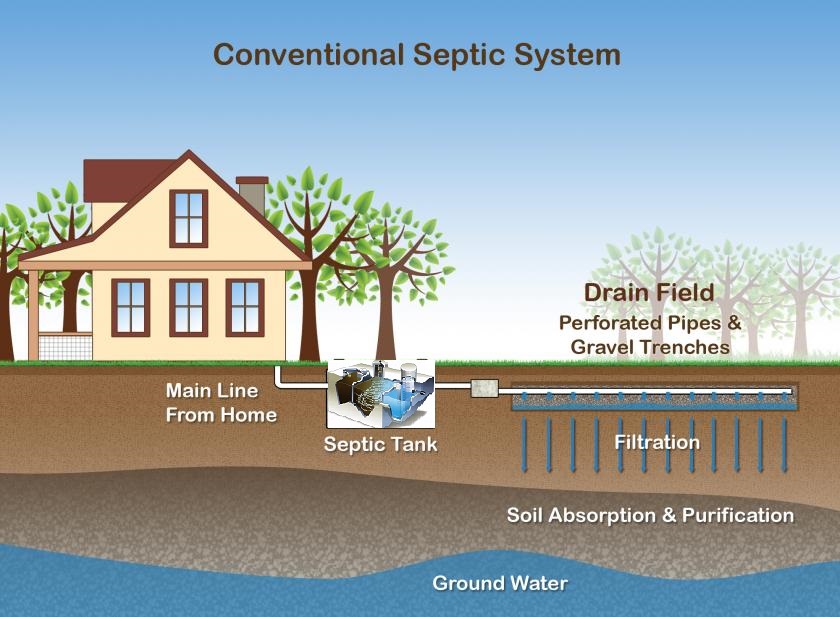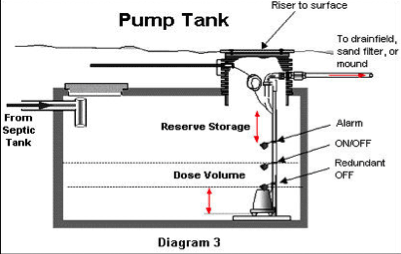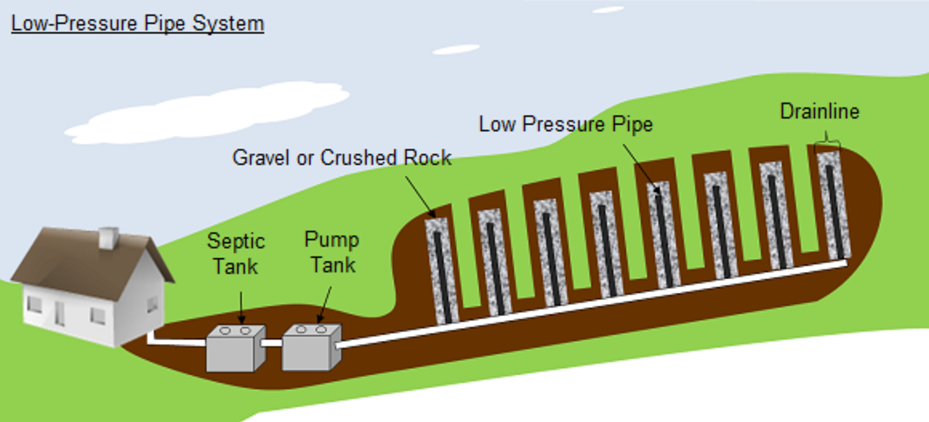Septic System Information
Did you know that as a homeowner you're responsible for maintaining your septic system? Did you know that maintaining your septic system protects your investment in your home? Did you know that you should periodically inspect your system and pump out your septic tank?
If properly designed, constructed and maintained, your septic system can provide long-term, effective treatment of household wastewater. If your septic system isn't maintained, you might need to replace it, costing you thousands of dollars. A malfunctioning system can contaminate groundwater that might be a source of drinking water. And if you sell your home your septic system must be in good working order.
Lateral (Pipe from house to tank): All of your household wastewater exits your home through a pipe to the septic tank.
WARNING: Don't go down into a septic tank. Toxic gases are produced by the natural treatment processes in septic tanks and can kill in minutes. Extreme care should be taken when inspecting a septic tank, even when just looking in.
SEPTIC TANK: The septic tank is a buried, watertight container typically made of concrete, fiberglass or polyethylene. It holds the wastewater long enough to allow solids to settle out (forming sludge) and oil and grease to float to the surface (as scum). It also allows partial decomposition of the solid materials. Compartments and a T-shaped outlet in the septic tank prevent the sludge and scum from leaving the tank and traveling into the drain field area.
DRAIN FIELD: The wastewater exits the septic tank and is discharged into the drain field for further treatment by the soil. The partially treated wastewater is pushed along to the drain field for further treatment every time new wastewater enters the tank. If the drain field is overloaded with too much liquid, it will flood, causing sewage to flow to the ground surface or create backups in plumbing fixtures and prevent treatment of all wastewater.
SOIL: Septic tank wastewater flows to the drain field, where it percolates into the soil, which provides final treatment by removing harmful bacteria, viruses, and nutrients. Suitable soil is necessary for successful wastewater treatment.
ALTERNATIVE ADVANCED SYSTEMS: Because many areas don't have soils suitable for a typical septic system, you might have or need an alternative system. You might also have or need an alternative system if there are too many typical septic systems in one area or the systems are too close to groundwater or surface waters. Alternative septic systems use new technology to improve treatment processes and might need special care and maintenance. Some alternative systems use sand, peat or plastic media instead of soil to promote wastewater treatment. Other systems might use wetlands, lagoons, aerators or disinfection devices. Floats, switches, pumps and other electrical or mechanical con1ponents are often used in alternative systems. Alternative systems should be inspected annually. Check with us for more information on operation and maintenance needs, if you have or need an alternative system.
Conventional Septic System
A conventional system uses gravity to distribute the effluent (waste) from the tank into the drain field. In this type of system there is a septic tank, a distribution box, and the drainfield. The drainfield on a conventional system can consists of runs of perforated pipe that the wastewater drips through led by gravity or a chamber system.
A leaching chamber is a wastewater treatment system consisting of trenches or beds, together with one or more distribution pipes or open-bottomed plastic chambers, installed in appropriate soils. These chambers receive wastewater flow from a septic tank or other treatment device and transmit it into soil for final treatment and disposal.
A typical septic tank system consists of a septic tank and a below-ground absorption field (also called a drain field, leaching field, or nitrification field). Leaching chambers are drainfields used to dispose of previously treated effluent. The drainfield system typically consists of leaching chambers installed in trenches and connected to the septic tank via pipe. Effluent flows out of the septic tank and is distributed into the soil through the leaching chamber system. The soil below the drainfield provides final treatment and disposal of the septic tank effluent. After the effluent has passed into the soil, most of it percolates downward and outward, eventually entering the shallow groundwater. A small portion of the effluent is used by plants through their roots or evaporates from the soil.
Source: EPA.gov
Drip Irrigation
A drip system may be composed of a "Class I" Aerator tank. This tank has a motor, timer and filter which purifies the effluent more than a regular tank. After the Class I Tank, there is a dosing tank with a motor and pump that doses the drain field under pressure.
The soil is dosed with effluent through a small diameter pipe with holes in it that has been installed with a plow. This system requires maintenance of the filters, pumps, floats, head pressure adjustment and flushing the lines.
This service should be performed by qualified personnel.
WE STRONGLY RECOMMEND A MAINTENANCE AGREEMENT FOR THIS TYPE OF SYSTEM.
Failure to maintain this system can result in expensive repair later.
Keeping traffic such as vehicles, heavy equipment, and livestock off your drain field is required.
Class 1 Tank
This is designed to purify your wastewater. This tank must comply with the "National Sanitation Foundation Standards No. 40." and be capable of treating 120 gallons per bedroom per day or five hundred gallons whichever is greater. This aeration unit utilitizes the principle of oxidation in the decomposition of sewage by introduction of air into the sewage. Some Class 1 tanks have filters installed inside to maximize the treatment of the liquids. This unit is required to be pumped. See the recommended pumping chart or as recommended by your particular usage requirement. We recommend that this unit be inspected by a professional on an annual basis. This unit also has a timer and alarm, which is usually located at the back of your home, possibly under a deck or inside your home by the electrical panel.
Pumps
Your Septic System has an effluent pump which pumps the effluent into the drain field. The location of this pump would be either on the 2nd cell of a combination septic tank OR in a separate concrete tank behind the septic tank.
MAINTENANCE SCHEDULE NEEDS TO INCLUDE THE FOLLOWING:
1. Remove pun1p from chamber to check and clean intake, suction plate and screen.
2. Check all valves for proper operation.
3. Inspect and clean all flow switches.
4. Return pump back into chamber and test.
A high water alarm is also installed, this is the red light above grade. The purpose of the high water alarm is in the event that the pump fails and the effluent rises in the pump chamber, the alarm/light will sound. In this case an emergency repair is needed ASAP. Be sure to test the alarm to ensure proper operation.
SIX-MONTH INSPECTIONS WOULD BE A GOOD RULE OF THUMB FOR PUMP MAINTENANCE.
FAILURE TO KEEP A MAINTENANCE SCHEDULE ON A SEPTIC SYSTEM CAN END UP AS A COSTLY MISTAKE.
Filter
Inside your septic tank, on the outlet side, you will find a filter. It is necessary to clean the filter as shown above at least every six months. If the filter becomes clogged, the effluent will overflow in the tank or may backup into your basement and come up through the floor drains. This is why it is VERY IMPORTANT to keep the filter clean. On the good side, the filter will keep the effluent that enters the drain field much cleaner and add years to the life of your system.
Curtain Drain
A "Curtain Drain" is a trench dug usually a minimum of 10 feet above your drainfeld, usually 6 inches to 12 inches wide. A four inch sock covered pipe is placed in the bottom of the trench. The trench is usually 12 inches below the depth required for your drain field. The trench is then filled with rock. The purpose of the curtain drain is to intercept the water that flows through the soil layers (usually in the wet time of the year).
The curtain drain then diverts the water around the drainfield to daylight. This prevents the drainfield from becoming saturated with excess water. Usually the only maintenance required for a curtain drain is to make sure that the ends are open and not clogged by leaves or other trash. Sometimes you will only have one end open to maintain.
Consult with us for the location of the curtain drain and outlets if you are not sure of the location.
Lagoon
A lagoon is probably the lowest maintenance system that can be installed. However periodic pumping is required. Also the Lagoon bank must be mowed annually and trees and brushy growth controlled. Trees cannot shade the lagoon. Sunlight is required. The fence, gate, and signs must also be maintained. If pumping the tank is neglected, sludge can fill the lagoon and a costly repair of pumping the lagoon and re-digging is required.
Low Pressure Pipe (LPP) System
A Low-Pressure Pipe (LPP) system is a shallow, pressure-dosed soil absorption system with a network of small diameter perforated pipes placed in narrow trenches. LPP systems were developed as an alternative to conventional soil absorption systems to eliminate problems such as: clogging of the soil from localized overloading, mechanical sealing of the soil trench during construction anaerobic conditions due to continuous saturation, and a high water table. The LPP system has the following design features that overcome these problems: 1) shallow placement, 2) narrow trenches, 3) continuous trenching, 4) pressure-dosed with uniform distribution of the effluent, 5) design based on areal loading, and 6) resting and reaeration between doses.
The main components of an LPP system are: a septic tank or an aerobic unit; pumping (dosing) chamber (submersible effluent pump, level controls, high water alarm, supply manifold), and small diameter distribution laterals with small perforations (holes).
Source: U.S. Environmental Protection Agency









